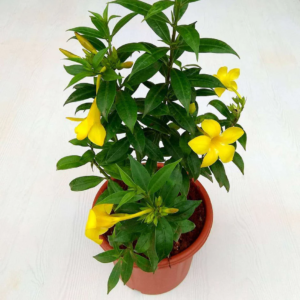Description
Tiger Alamanda (Allamanda cathartica var. ‘Tiger’) – A Stunning Tropical Beauty
Overview
The Tiger Alamanda (Allamanda cathartica var. ‘Tiger’) is a breathtaking tropical vine admired for its bold, vibrant blooms that captivate any landscape. Its large, trumpet-shaped flowers are a striking blend of bright yellow with distinctive orange to reddish streaks, resembling the fierce pattern of a tiger’s coat. This unique coloration sets it apart from the more common Allamanda varieties, making it a favorite among garden enthusiasts and landscapers alike.
Botanical Characteristics
- Scientific Name: Allamanda cathartica var. ‘Tiger’
- Common Names: Tiger Alamanda, Striped Alamanda
- Family: Apocynaceae (Dogbane family)
- Type: Evergreen shrub or vine
- Origin: Native to South and Central America, particularly in regions of Brazil
The Tiger Alamanda features glossy, dark green leaves that provide a lush backdrop for its stunning flowers. Leaves are typically ovate, with a leathery texture, arranged oppositely along the vine. When in full bloom, the plant is covered in vivid blossoms that measure around 3 to 4 inches in diameter, creating a dazzling display throughout the warmer months.
Habitat and Growth
Tiger Alamanda thrives in tropical and subtropical regions where temperatures remain consistently warm. It prefers:
- Sunlight: Full sun (at least 6-8 hours of direct sunlight daily)
- Soil: Well-drained, slightly acidic to neutral soil (pH 5.5 – 7.0)
- Water: Regular watering, ensuring the soil remains moist but not waterlogged
- Climate: Best suited for USDA hardiness zones 9-11
In its natural habitat, this vine can grow vigorously, reaching heights of 10 to 15 feet if given proper support. It is often used to cover trellises, fences, and arbors, where its cascading flowers can be fully appreciated.
Care and Maintenance
Tiger Alamanda is relatively low-maintenance once established. Key care tips include:
- Pruning: Regular pruning helps control its size and encourages bushier growth. Trim back in early spring before the growing season begins.
- Fertilization: Apply a balanced, slow-release fertilizer once every three months to promote healthy blooms.
- Pest Control: Monitor for common pests like aphids and spider mites. Neem oil or insecticidal soap can effectively manage minor infestations.
- Winter Care: In cooler climates, Tiger Alamanda should be grown in pots and brought indoors during the winter months, as it is sensitive to frost.
Landscaping Uses
The Tiger Alamanda’s stunning flowers make it ideal for:
- Garden Borders: Its dense foliage and bright flowers are perfect for accentuating garden paths and borders.
- Trellises and Arbors: The vine’s climbing nature allows it to beautifully drape over garden structures.
- Container Planting: Perfect for patios and balconies where its vibrant blooms can be enjoyed up close.
- Hedges and Privacy Screens: When allowed to grow freely, it can serve as a living barrier.
Propagation
Propagation of Tiger Alamanda is typically done through stem cuttings. Select healthy, semi-hardwood cuttings and root them in well-draining soil under warm, humid conditions. Roots typically develop within 4 to 6 weeks.
Toxicity Warning
All parts of the Tiger Alamanda are considered toxic if ingested, as they contain compounds that can cause stomach discomfort. It is advisable to keep this plant away from pets and small children.
Conclusion
Tiger Alamanda is an exceptional choice for anyone looking to add a touch of tropical vibrancy to their garden. With its dazzling tiger-striped blooms and lush green foliage, it brings a sense of exotic elegance to any landscape. Proper care and placement can reward gardeners with stunning displays season after season.







Reviews
There are no reviews yet.